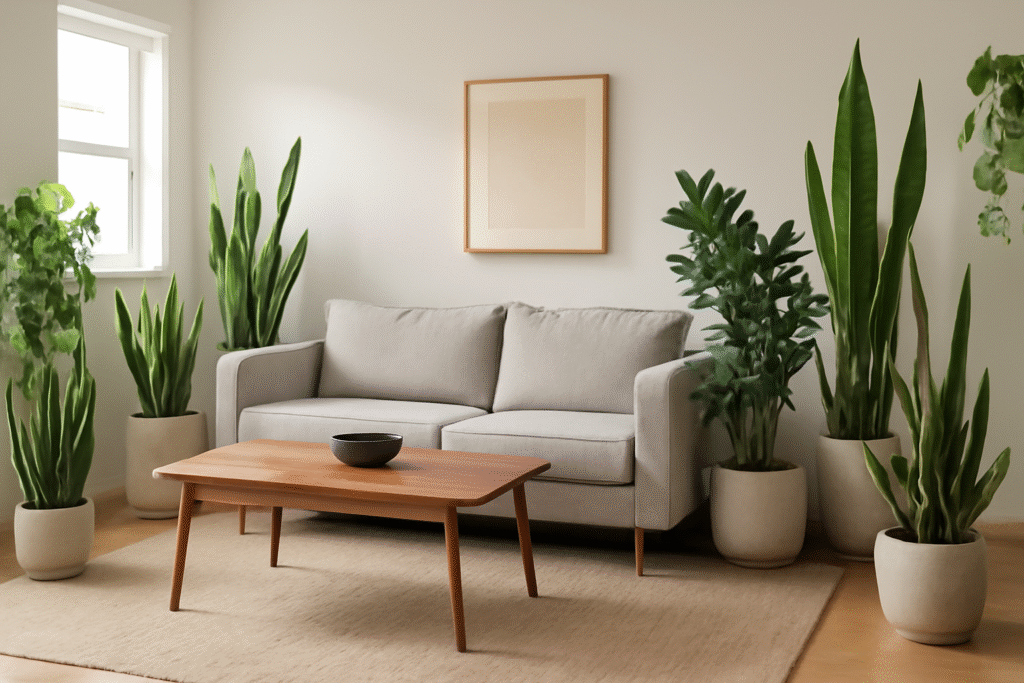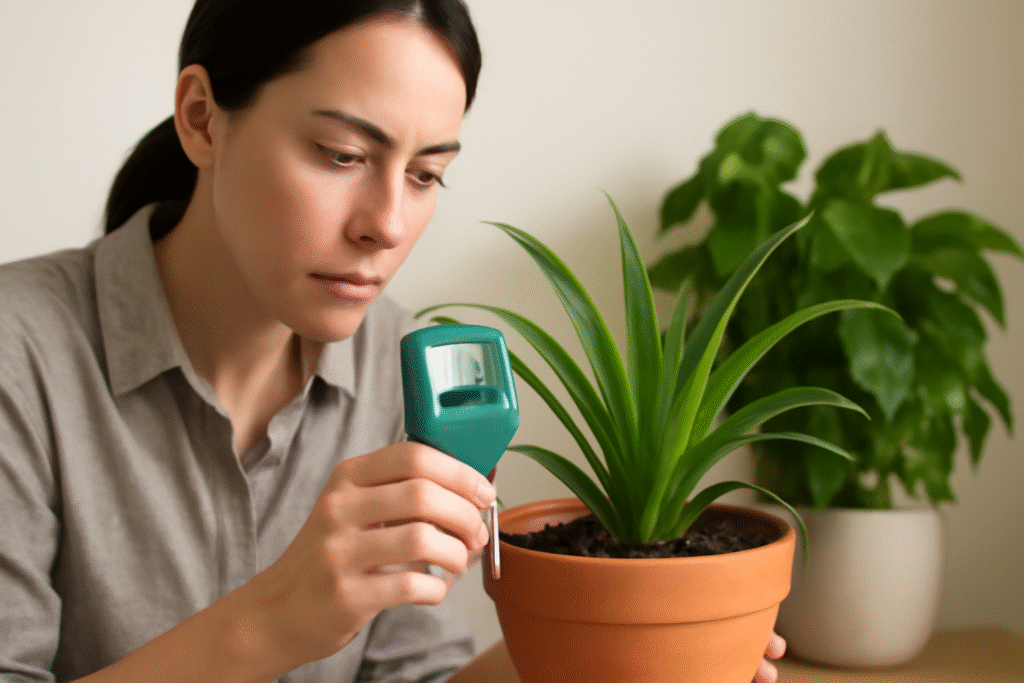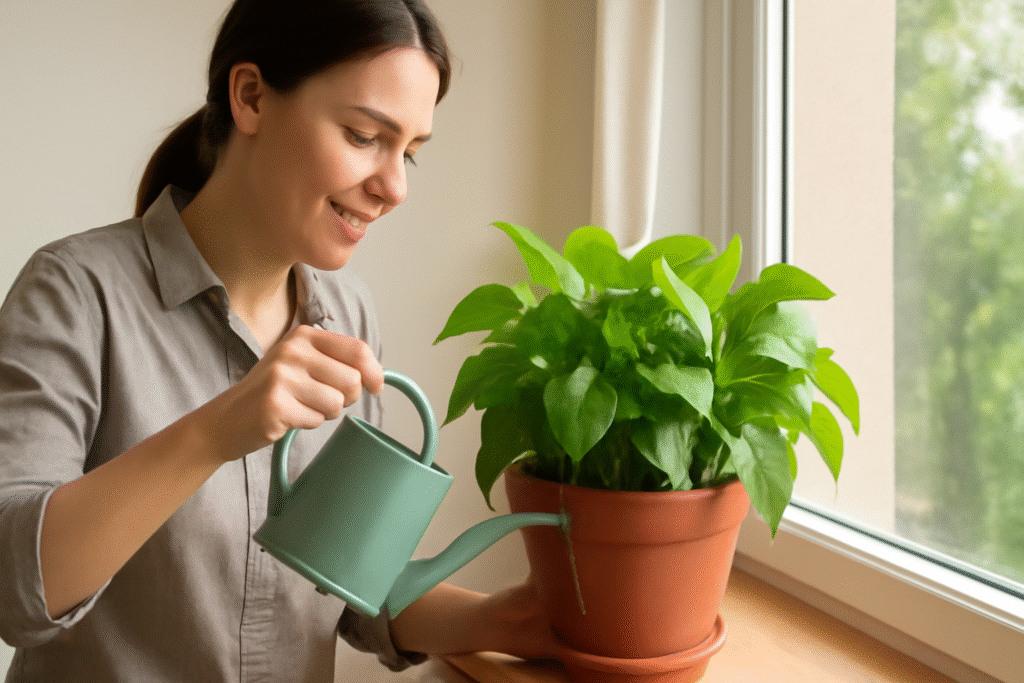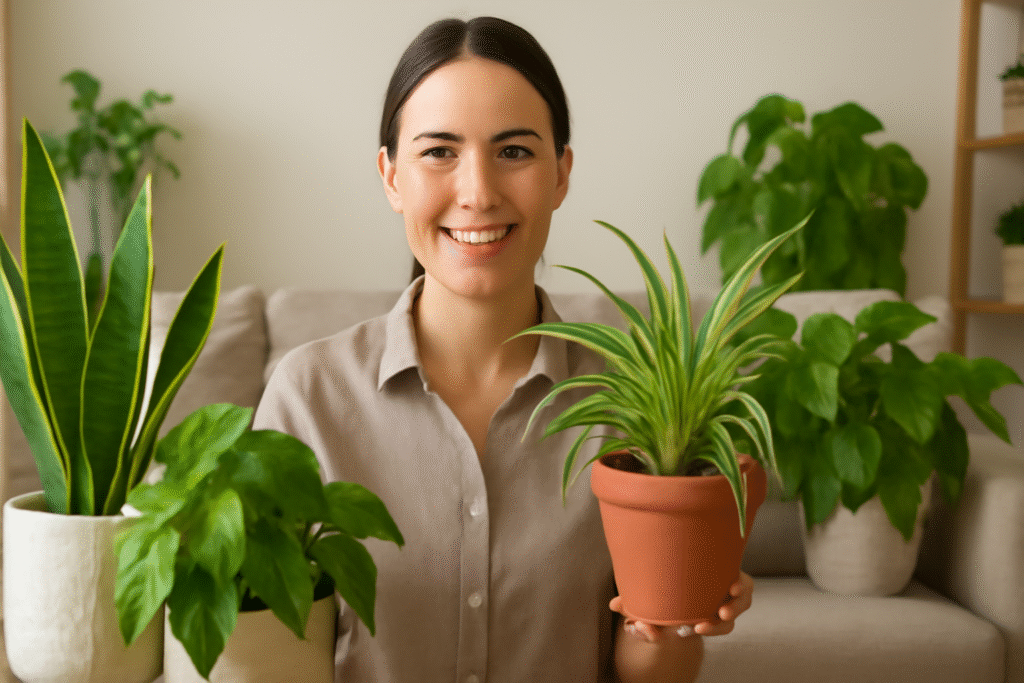
Best Indoor Plants for Beginners: Easy-to-Care Options That Will Thrive in Your Home
If you’ve ever felt the urge to bring a little greenery into your home but feared the upkeep, you’re not alone! 
In this guide, we’ll show you exactly which plants are perfect for newcomers to indoor gardening, and how to make sure they grow strong and healthy. Forget about worrying over wilting leaves or overwatering mistakes—by the end of this article, you’ll have the confidence to choose and care for plants that will brighten up your space with ease. Ready to transform your home into a plant paradise? Let’s dive in!
Table of Contents
ToggleTop 10 Best Indoor Plants for Beginners
When you’re just starting out with indoor plants, it’s essential to choose varieties that are easy to care for and tolerant of beginner mistakes. The following list features the best indoor plants for beginners that will thrive in your home with minimal effort. These plants are low-maintenance, resilient, and beautiful additions to any room. Let’s take a closer look!
1. Snake Plant (Sansevieria)
- Why it’s perfect for beginners: The Snake Plant is nearly indestructible! It thrives on neglect, making it a top pick for new plant parents. It tolerates low light and only needs to be watered every 2-3 weeks.
- Care Tips:
- Water sparingly (let the soil dry out completely before watering).
- Place in indirect light, but it can also handle low light conditions.
2. Spider Plant (Chlorophytum comosum)
- Why it’s perfect for beginners: Spider Plants are super easy to grow and produce cute little plantlets that can be propagated into new plants! They also thrive in a variety of lighting conditions.
- Care Tips:
- Water when the soil is dry to the touch.
- Keep it in bright, indirect light for best growth.
3. Pothos (Epipremnum aureum)
- Why it’s perfect for beginners: Known for its forgiving nature, Pothos is an excellent choice for beginners. It can grow in low light and only needs occasional watering. Plus, its trailing vines add a touch of greenery to any space.
- Care Tips:
- Water when the soil feels dry.
- Thrives in low to bright indirect light.
4. ZZ Plant (Zamioculcas zamiifolia)
- Why it’s perfect for beginners: The ZZ Plant is an excellent choice for those with little natural light in their homes. It’s drought-tolerant and thrives in neglect, making it nearly impossible to kill!
- Care Tips:
- Water only when the soil is completely dry.
- Prefers indirect light but can tolerate low light.
5. Aloe Vera
- Why it’s perfect for beginners: Aloe Vera is a succulent that requires minimal attention. It’s perfect for windowsills where it can soak up the sun. Plus, it’s famous for its soothing gel, which can be used for burns and skin irritations.
- Care Tips:
- Water only when the soil is dry (about once every 2-3 weeks).
- Needs bright, direct sunlight.
6. Peace Lily (Spathiphyllum)
- Why it’s perfect for beginners: Peace Lilies are beautiful and known for their air-purifying qualities. They’re relatively easy to care for and can tolerate low light, though they do best with moderate indirect light.
- Care Tips:
- Keep the soil consistently moist but not soggy.
- Avoid placing it in direct sunlight, as it may scorch the leaves.
7. Dracaena
- Why it’s perfect for beginners: Dracaena plants are elegant and stylish with their long, slender leaves. They’re low-maintenance, requiring only occasional watering and indirect light.
- Care Tips:
- Water when the top 2 inches of soil feel dry.
- Prefers bright, indirect light but can tolerate low light.
8. Chinese Evergreen (Aglaonema)
- Why it’s perfect for beginners: Chinese Evergreen plants are incredibly adaptable to various indoor conditions. They can survive with little natural light and are resilient to neglect.
- Care Tips:
- Water when the top layer of soil is dry.
- Prefers indirect light, but can tolerate low light.
9. Jade Plant (Crassula ovata)
- Why it’s perfect for beginners: Jade Plants are succulents that require little water and can live for years with the proper care. Their thick, glossy leaves add a touch of beauty to any space.
- Care Tips:
- Water once every 2-3 weeks or when the soil feels dry.
- Needs bright, indirect light or some direct sunlight.
10. Philodendron
- Why it’s perfect for beginners: Philodendrons are incredibly easy to care for and grow quickly. They’re great for hanging baskets or allowing their vines to trail.
- Care Tips:
- Water when the top 1-2 inches of soil are dry.
- Thrives in indirect sunlight but can adapt to lower light conditions.

Common Mistakes Beginners Make with Indoor Plants and How to Avoid Them
Starting your indoor plant journey can be exciting, but it’s easy to make a few mistakes along the way. 
1. Overwatering Your Plants 
One of the most common mistakes new plant owners make is overwatering. It might seem like the more you water, the better, but too much water can lead to root rot and yellowing leaves.
- How to avoid it: Always check the soil before watering. Stick your finger about 1-2 inches into the soil—if it feels dry, it’s time to water; if it’s still moist, wait a few days. Most indoor plants prefer to dry out a bit between waterings.
- Tip: Make sure your pots have drainage holes to prevent water from sitting at the bottom and causing root rot.
2. Placing Plants in the Wrong Light 
Each plant has specific light needs, and placing them in the wrong spot can lead to poor growth or even death. Too much sunlight can scorch leaves, while too little can cause them to become leggy or stop growing altogether.
- How to avoid it: Research your plant’s light requirements and place it accordingly. For example, Snake Plants thrive in low light, while Aloe Vera prefers direct sunlight.
- Tip: If you’re unsure, place your plant in a spot with bright, indirect light to start. You can always adjust it based on how it responds!
3. Ignoring the Plant’s Size and Space Needs 
When you’re choosing a plant, it’s important to consider how big it will grow. Some plants, like the Peace Lily, start small but can eventually outgrow a space, becoming overcrowded or difficult to manage.
- How to avoid it: Consider the plant’s full-grown size before choosing a spot. Don’t be afraid to repot your plants as they grow to give them more space.
- Tip: If you’re short on space, opt for smaller plants or trailing varieties like Pothos or Spider Plants, which can be placed on shelves or hung in baskets.
4. Not Using Proper Containers 
Using a pot without drainage holes is a big mistake. Without proper drainage, water can accumulate at the bottom of the pot, suffocating the roots and causing rot.
- How to avoid it: Always use pots with drainage holes. This helps water flow through and ensures your plant’s roots don’t sit in water.
- Tip: If you love a pot without holes, simply place a plastic liner inside it and use it as a decorative outer container, but keep the plant in a pot with drainage.
5. Forgetting to Fertilize 
While plants don’t need fertilizer every day, they still need nutrients to grow healthy and strong. Over time, the soil loses its nutrients, which can stunt your plant’s growth.
- How to avoid it: Feed your plants with a balanced fertilizer every 4-6 weeks during the growing season (spring and summer). During fall and winter, most plants go dormant and don’t require fertilizer.
- Tip: Always follow the recommended instructions on the fertilizer packaging—too much fertilizer can burn the roots.
6. Not Monitoring Temperature and Humidity 
Indoor plants are sensitive to temperature changes and humidity levels. Placing them near heaters, air conditioners, or drafty windows can cause stress and poor growth.
- How to avoid it: Keep your plants away from extreme temperatures and drafts. Most indoor plants prefer temperatures between 65-75°F (18-24°C).
- Tip: If your home is dry, especially in the winter, consider using a humidity tray or a small humidifier to keep your plants happy. Some plants, like Peace Lilies, thrive with higher humidity levels.
7. Underestimating the Power of Regular Care 
It’s easy to forget about your plants when life gets busy, but neglecting them can lead to poor health. Regular care is key to ensuring they stay vibrant and strong.
- How to avoid it: Create a simple care routine. Water your plants on a set schedule, check for pests, and remove dead leaves as needed.
- Tip: Set a reminder on your phone or mark it on your calendar so you remember to check on your plants weekly.

How to Care for Your Indoor Plants: A Beginner’s Guide
Caring for indoor plants doesn’t have to be complicated. With just a few simple steps, you can ensure that your plants stay healthy and happy. 
1. Watering Your Plants 
Watering is crucial to plant health, but it’s easy to get it wrong. Overwatering and underwatering are two of the most common mistakes. Here’s how to do it right:
- How to Water:
- Check the soil: Before watering, stick your finger into the soil about 1-2 inches deep. If it feels dry, it’s time to water. If it’s still moist, wait a few days.
- Water thoroughly: Water the plant until the water runs out of the drainage holes at the bottom. This ensures the roots are fully hydrated.
- Tip: Different plants have different water needs. For example, succulents like Aloe Vera need watering every 2-3 weeks, while plants like Peace Lilies prefer consistently moist soil.
2. Lighting: Finding the Right Spot 
Plants thrive when placed in the right light conditions. Understanding how much light your plants need is key to their health. Here’s how to make sure they’re getting enough light:
- Low light plants: Some plants, like Snake Plants and ZZ Plants, do well in low light and can even thrive in rooms with minimal natural sunlight.
- Bright, indirect light: Most plants, including Spider Plants and Philodendrons, do best in bright, indirect light. Place them near windows that don’t get direct sunlight.
- Direct sunlight: Plants like Aloe Vera and succulents love direct sunlight. Place them on windowsills where they can soak up the sun for several hours a day.
- Tip: If you’re unsure about the light in your home, start by placing your plant near a window and observe how it responds. If the leaves start to yellow, it’s likely getting too much direct sunlight.
3. Humidity: Keeping Your Plants Happy 
Humidity plays a big role in plant health, especially for tropical plants. While many indoor plants can tolerate average household humidity, some, like Peace Lilies and Ferns, need a little extra moisture in the air.
- How to Increase Humidity:
- Group plants together: Plants naturally create a humid microclimate around themselves, so grouping them together can help maintain humidity.
- Use a humidity tray: Place a shallow tray filled with water and pebbles under your plant pots. As the water evaporates, it increases the humidity around the plants.
- Use a humidifier: If your home is very dry, especially in the winter, consider using a humidifier to keep the air moist.
- Tip: If you see your plants’ leaves turning brown or curling, it could be a sign that the air is too dry for them. Try increasing humidity and observe if it helps.
4. Fertilizing: Feeding Your Plants 
Just like any living thing, plants need food to grow. Fertilizing is essential to keep your plants healthy and thriving.
- When to Fertilize: Most indoor plants need to be fertilized during the growing season (spring and summer). During fall and winter, plants generally go dormant and don’t need fertilizing.
- What to Use: Choose a balanced, all-purpose houseplant fertilizer. You can find liquid or slow-release options—just make sure to follow the manufacturer’s instructions.
- How to Fertilize:
- Dilute fertilizer: For liquid fertilizers, dilute them to half the recommended strength to avoid overfeeding.
- Apply regularly: Apply fertilizer every 4-6 weeks during the growing season. Avoid fertilizing your plants during their dormant phase.
- Tip: Over-fertilizing can lead to burnt roots, so always use the correct dosage.
5. Repotting: Giving Your Plants Room to Grow 
As your plants grow, they may outgrow their pots, causing their roots to become cramped. Repotting is essential to keep your plants healthy and allow them to flourish.
- When to Repot: Repot your plant every 1-2 years or when you notice roots growing out of the drainage holes or the plant has stopped growing.
- How to Repot:
- Choose a pot that’s 1-2 inches larger in diameter than the current pot.
- Gently remove the plant from its current pot, loosen the roots, and place it in the new pot.
- Fill with fresh potting mix, ensuring the plant is at the same soil level as it was in the old pot.
- Tip: Repot your plants in spring or early summer to give them the best chance to establish new roots.
6. Cleaning Your Plants 
Plants naturally collect dust on their leaves, which can block sunlight and make it harder for them to photosynthesize. Regular cleaning keeps your plants looking fresh and healthy.
- How to Clean:
- Wipe the leaves: Use a damp cloth to gently wipe the leaves of your plants. For larger plants, you can rinse them with a gentle stream of water in the sink or shower.
- Dusting: Use a soft brush to remove dust from smaller plants or those with delicate leaves.
- Tip: Clean your plants every couple of weeks to ensure they’re absorbing enough sunlight and looking their best!

How to Troubleshoot Common Problems with Indoor Plants
Even the easiest-to-care-for indoor plants can face problems from time to time. 
1. Yellowing Leaves 
Yellowing leaves are one of the most common plant issues, and it can happen for several reasons.
- Possible Causes:
- Overwatering: If the soil stays too wet, the roots can suffocate, leading to yellowing leaves.
- Underwatering: If you forget to water your plant, the leaves will start turning yellow as the plant gets stressed.
- Low Light: Some plants may start yellowing if they’re not getting enough light.
- How to Fix It:
- Check your watering: Ensure you’re not overwatering or underwatering. Let the soil dry out between waterings if necessary.
- Improve lighting: Move the plant to a brighter spot if it’s not getting enough light.
- Prune the yellow leaves: Remove yellow leaves to help the plant focus energy on healthy growth.
2. Brown Leaf Tips 
Brown, crispy tips are another common problem that usually indicates that something is off with your plant’s care.
- Possible Causes:
- Low Humidity: Dry indoor air can cause the edges of leaves to dry out and turn brown.
- Over-fertilizing: Too much fertilizer can burn the tips of the leaves, causing them to turn brown.
- Underwatering: When plants aren’t watered enough, the leaf edges can dry out and become crispy.
- How to Fix It:
- Increase humidity: Group your plants together, use a humidity tray, or place a humidifier nearby to add moisture to the air.
- Water correctly: Make sure to water your plant thoroughly when the soil is dry.
- Fertilize properly: Cut back on fertilizer if you’ve been overfeeding your plant, and always follow the manufacturer’s instructions.
3. Wilting or Drooping Leaves 
When a plant’s leaves droop or wilt, it’s a sign that something is stressing it out.
- Possible Causes:
- Overwatering: Excess water can cause the roots to rot, leading to wilting leaves.
- Underwatering: On the flip side, if you’re not watering your plant enough, it can also cause the leaves to droop.
- Environmental Stress: Plants may droop if they’re in a spot with fluctuating temperatures or drafts.
- How to Fix It:
- Check the soil moisture: Water the plant if the soil is dry, but make sure the pot has drainage holes so excess water can escape.
- Avoid drafts: Keep your plant away from air conditioners, heaters, or windows with temperature fluctuations.
- Assess your watering routine: If you’ve been overwatering, let the soil dry out before watering again.
4. Leaves Turning Black or Mushy 
Black or mushy leaves are a sign of serious issues, usually related to overwatering or a fungal infection.
- Possible Causes:
- Overwatering: Too much water can cause the roots to rot, leading to black, mushy spots on the leaves.
- Fungal Infection: A common issue in overly wet conditions, fungal infections can cause black spots and moldy growth on leaves.
- How to Fix It:
- Remove affected leaves: Prune any black or mushy leaves to prevent the spread of disease.
- Check for root rot: If the roots look brown or mushy when you remove the plant from its pot, trim off the rotting roots and repot the plant in fresh, well-draining soil.
- Water less frequently: Ensure you’re not overwatering, and always let the soil dry out between waterings.
5. Leggy Growth (Stretched Out) 
If your plant is looking long, spindly, or “leggy,” it means it’s not getting enough light, and it’s stretching toward the nearest light source.
- Possible Causes:
- Insufficient Light: When plants don’t get enough light, they start to reach for it by growing tall and weak.
- Too Much Fertilizer: Over-fertilizing can encourage excessive growth, but the plant will lack the strength to hold itself up.
- How to Fix It:
- Move your plant to brighter light: Place it in a spot where it gets more natural sunlight. If that’s not possible, consider using grow lights.
- Prune leggy growth: Trim back the stretched stems to encourage bushier, healthier growth.
- Adjust your fertilizing routine: Fertilize sparingly and follow instructions to avoid encouraging weak, leggy growth.
6. Pests (Spider Mites, Aphids, etc.) 
Pests can often sneak into your indoor garden, feeding on your plants and causing damage.
- Common Pests:
- Spider mites: Tiny, web-spinning insects that often appear on the undersides of leaves.
- Aphids: Small, soft-bodied insects that can be found on new growth or flower buds.
- Mealybugs: White, cotton-like insects that feed on plant sap.
- How to Fix It:
- Inspect regularly: Check your plants for pests, especially on the underside of leaves and stems.
- Treat with neem oil: Neem oil is a natural pesticide that’s safe for most plants and can be sprayed directly on the affected areas.
- Remove pests by hand: For small infestations, gently wipe pests off with a damp cloth or use a soft brush.

Building Your Confidence with Indoor Plants
Congratulations! You’re now equipped with all the tools you need to confidently care for your indoor plants and create a thriving green space in your home. 
By choosing the best indoor plants for beginners, avoiding common mistakes, and following the simple care tips we’ve shared, you can ensure your plants grow strong and healthy. 
Indoor plants not only enhance your home’s aesthetics but also contribute to a calming, positive atmosphere that can boost your mood and improve air quality. So, get ready to enjoy the rewards of your efforts—your plants are sure to thrive under your care.
With time, you’ll gain even more confidence as a plant parent and discover how rewarding it is to watch your green friends grow. Happy planting!

Frequently Asked Questions (FAQ)
1. What are the easiest indoor plants for beginners?
Some of the easiest indoor plants for beginners include Snake Plants, Pothos, Spider Plants, ZZ Plants, and Aloe Vera. These plants are low-maintenance, tolerant of neglect, and can thrive in various light conditions, making them perfect for newcomers to plant care.
2. How often should I water indoor plants?
Watering frequency depends on the plant and its environment, but as a general rule, wait until the top 1-2 inches of soil feel dry before watering. Plants like Snake Plants and ZZ Plants can go a few weeks without water, while others, like Peace Lilies, prefer consistently moist soil.
3. Can indoor plants survive without direct sunlight?
Yes, many indoor plants, such as Snake Plants and ZZ Plants, can thrive in low or indirect light. However, most plants will grow best with some natural light, so it’s important to understand each plant’s light needs and place them in suitable spots.
4. How do I know if my plant needs more sunlight?
If your plant’s leaves are turning yellow, becoming leggy, or stretching toward a light source, it may need more sunlight. Try moving it closer to a window with bright, indirect light or using a grow light if your home lacks natural sunlight.
5. What should I do if my plant's leaves are turning brown?
Brown leaf tips usually result from underwatering, low humidity, or too much direct sunlight. Make sure to water your plant correctly, increase humidity if necessary, and move it away from direct sun exposure to prevent further damage.
6. How can I prevent overwatering my indoor plants?
To avoid overwatering, ensure your pots have drainage holes and let the soil dry out between waterings. Always check the moisture level of the soil before watering—if it’s still moist, wait a few more days.
7. What type of soil is best for indoor plants?
Well-draining, nutrient-rich potting soil is best for most indoor plants. For succulents or cacti, use a mix specifically designed for them, as they require good drainage to prevent root rot. Always ensure the soil suits your plant’s specific needs.
8. How do I know if my indoor plant has pests?
Look for signs such as discolored or damaged leaves, sticky residue, or tiny insects on the underside of the leaves. Common indoor plant pests include aphids, spider mites, and mealybugs. Treat with neem oil or insecticidal soap if pests are found.



